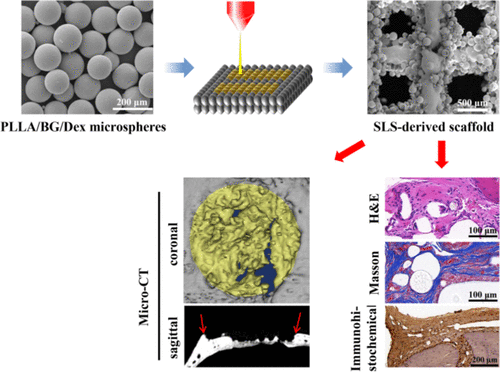当前位置:
X-MOL 学术
›
ACS Appl. Bio Mater.
›
论文详情
Our official English website, www.x-mol.net, welcomes your
feedback! (Note: you will need to create a separate account there.)
A Dexamethasone-Eluting Porous Scaffold for Bone Regeneration Fabricated by Selective Laser Sintering
ACS Applied Bio Materials ( IF 4.6 ) Pub Date : 2020-11-17 , DOI: 10.1021/acsabm.0c01126 Zhidong Sun 1, 2, 3 , Fan Wu 4, 5 , Huichang Gao 6 , Kai Cui 1, 2 , Mengyue Xian 1, 2 , Jianglong Zhong 5 , Ye Tian 7 , Song Fan 4, 5 , Gang Wu 1, 2, 8
ACS Applied Bio Materials ( IF 4.6 ) Pub Date : 2020-11-17 , DOI: 10.1021/acsabm.0c01126 Zhidong Sun 1, 2, 3 , Fan Wu 4, 5 , Huichang Gao 6 , Kai Cui 1, 2 , Mengyue Xian 1, 2 , Jianglong Zhong 5 , Ye Tian 7 , Song Fan 4, 5 , Gang Wu 1, 2, 8
Affiliation

|
Additive manufacture (AM) has been widely and rapidly applied in fabrication of 3D porous scaffolds for tissue engineering applications. For synthetic polymers of high melting temperature, the melting-extruding technique is the most applied AM method for such fabrication of polymer porous scaffolds. This results in a big challenge to directly process the scaffolds using the polymers and thermosensitive substances simultaneously because of deactivation under high temperature. In this article, the selective laser sintering (SLS) method was proposed to make a poly(l-lactic acid) (PLLA) porous scaffold containing dexamethasone (Dex) simultaneously. Dex was encapsulated in two groups of PLLA–bioactive glass (BG) composite microspheres with an average diameter of 115–120 μm and loading amounts of 0.68 ± 0.09 and 0.84 ± 0.10 μg/mg, respectively. The drug-loading composite microspheres were then fabricated into scaffolds under a laser fluence of 0.83–2.08 J/mm2. The average pore size and compressive modulus for the porous scaffold were 450–500 μm and 18–25 MPa, respectively. Drug release experiments showed that Dex was released from the scaffold in a controlled manner until about a month. The eluting time of HPLC tests before or after SLS processing both presented at 4 min indicated no chemical structure changes for the drug. Ex vivo cell experiments also testified the comparable effect of released Dex with commercial products, showing that the bioactivities were not affected after SLS. Implantation of the composite scaffolds in rat cranium defects demonstrated that new bone and blood vessel formation was faster in the Dex-releasing scaffolds than in the groups without drug loading.
中文翻译:

选择性激光烧结制备的用于骨再生的地塞米松洗脱多孔支架
增材制造 (AM) 已广泛且迅速地应用于组织工程应用的 3D 多孔支架的制造。对于高熔融温度的合成聚合物,熔融挤出技术是制备聚合物多孔支架最常用的增材制造方法。由于在高温下失活,这导致了同时使用聚合物和热敏物质直接加工支架的巨大挑战。在本文中,提出了选择性激光烧结(SLS)方法来制备聚(l-乳酸) (PLLA) 多孔支架同时含有地塞米松 (Dex)。Dex 被封装在两组 PLLA-生物活性玻璃 (BG) 复合微球中,平均直径为 115-120 μm,负载量分别为 0.68 ± 0.09 和 0.84 ± 0.10 μg/mg。然后在0.83-2.08 J/mm 2的激光能量密度下将载药复合微球制成支架. 多孔支架的平均孔径和压缩模量分别为 450-500 μm 和 18-25 MPa。药物释放实验表明,Dex 以受控方式从支架中释放出来,直到大约一个月。SLS 处理之前或之后的 HPLC 测试的洗脱时间均为 4 分钟,表明药物的化学结构没有变化。离体细胞实验也证明了释放的 Dex 与商业产品的效果相当,表明 SLS 后生物活性不受影响。在大鼠颅骨缺损中植入复合支架表明,在释放 Dex 的支架中,新骨和血管的形成速度比没有载药的组更快。
更新日期:2020-12-21
中文翻译:

选择性激光烧结制备的用于骨再生的地塞米松洗脱多孔支架
增材制造 (AM) 已广泛且迅速地应用于组织工程应用的 3D 多孔支架的制造。对于高熔融温度的合成聚合物,熔融挤出技术是制备聚合物多孔支架最常用的增材制造方法。由于在高温下失活,这导致了同时使用聚合物和热敏物质直接加工支架的巨大挑战。在本文中,提出了选择性激光烧结(SLS)方法来制备聚(l-乳酸) (PLLA) 多孔支架同时含有地塞米松 (Dex)。Dex 被封装在两组 PLLA-生物活性玻璃 (BG) 复合微球中,平均直径为 115-120 μm,负载量分别为 0.68 ± 0.09 和 0.84 ± 0.10 μg/mg。然后在0.83-2.08 J/mm 2的激光能量密度下将载药复合微球制成支架. 多孔支架的平均孔径和压缩模量分别为 450-500 μm 和 18-25 MPa。药物释放实验表明,Dex 以受控方式从支架中释放出来,直到大约一个月。SLS 处理之前或之后的 HPLC 测试的洗脱时间均为 4 分钟,表明药物的化学结构没有变化。离体细胞实验也证明了释放的 Dex 与商业产品的效果相当,表明 SLS 后生物活性不受影响。在大鼠颅骨缺损中植入复合支架表明,在释放 Dex 的支架中,新骨和血管的形成速度比没有载药的组更快。











































 京公网安备 11010802027423号
京公网安备 11010802027423号